Practical advice - building a campervan
Words & Photos: Mike Trippitt
Peter Burton’s metallic grey Fiat Ducato is no ordinary campervan. Peter, who has spent 12 months converting the high-top long- wheelbase van, is no ordinary camper. It’s not the first time he’s turned his trade skills to a self-build project.
“I was mad on boats,” the retired builder and former marine joiner told Campervan. “In 1963 I built a two-man canoe, and then in 1973, I did a speedboat. I wanted to progress to a cabin cruiser, and was mad on the idea of being self-contained and independent from everything else around.”
Nevertheless, his young wife, Sandra, was not keen on the speedboat so, with future boating plans shelved, he looked for the next best thing….
The beginning of the campervan experience
Although it would be another 50 years before the Ducato arrived, Peter reflects affectionately on his first campervan experience in 1967, when he first got the bug. His parents would hire a VW T2 every year for their summer holidays, as they couldn’t afford to buy one, but eventually, Peter bought a camper for him and Sandra in 1967.
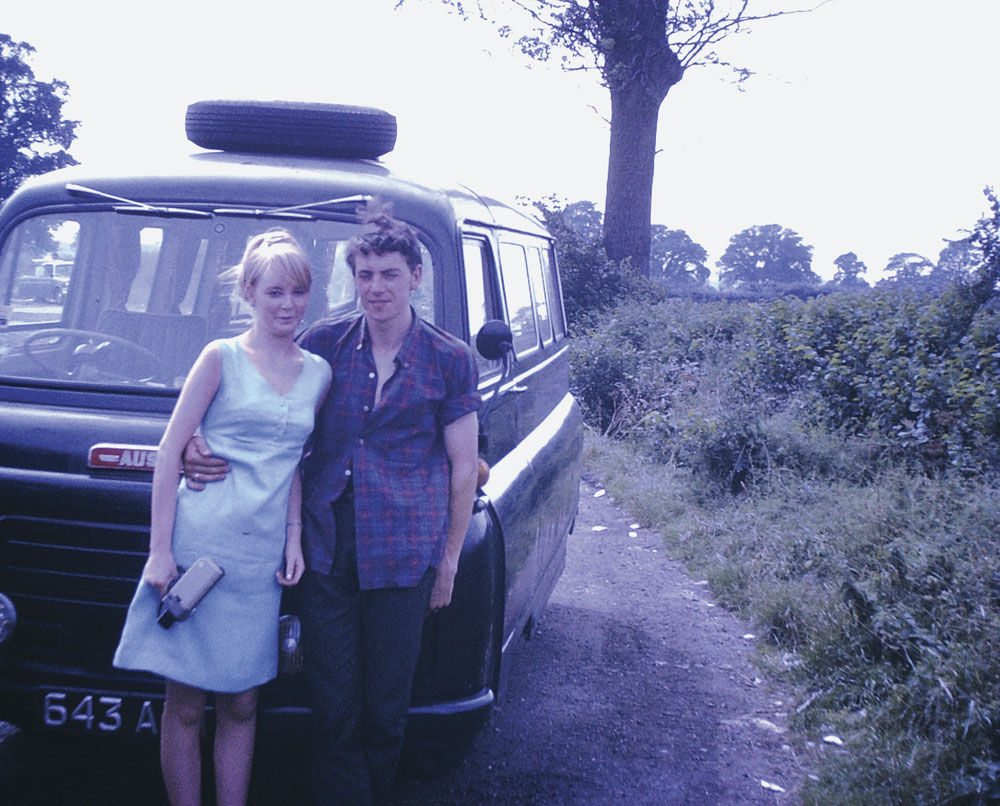
“It was a converted 1959 Austin A152 Omnicoach,” he recalled. “It was eight years old, black, and I think it had belonged to the police force. It was nothing fancy, but it felt like luxury to us. We did about 800 miles without any bother. We had a lovely time living on a shoestring around Devon and Cornwall.”
Once children came along, Peter and Sandra enjoyed several years of caravanning, but their touring came to an end when their daughter, by then 14 years old, announced boldly: “If you think I'm coming with you this time next year, you're mistaken!”
Peter said: “We all get to where the family grows up, and teenagers like my daughter don't want to be coming with you. That’s when we got rid of the caravan. We sold it with a heavy heart, and were sorry to see it go.”
The best laid campervan plans
Having fitted out motor cruisers and sailing yachts, and then spending 45 years in the building trade, Peter always planned to convert his last Ford Transit work van into a camper when the time came to hang up his builder’s tools. The desire to be self-contained and independent was still there.
Though he had the skills to convert the Transit, he foresaw a problem. Without fitting a pop-top it was not high enough to stand up in, nor was it long enough for what he had in mind. A rethink was required and, on a friend’s recommendation, he turned his attention to the Fiat.
“When I started looking into the Ducato I went along to the local dealer and took one for a test drive. I decided that I definitely wanted a Ducato and ended up buying mine from a garage in Rotherham for £15,000. It was six months old and had only done 3,500 miles. Bargain of the century!”
Peter and Sandra had seen numerous photos taken inside campervans and had a good idea of what they wanted, but there was no diagram or blueprint. “It’s what we call in the trade ‘scratch-built’. I didn’t use plans. I could say I made it up as I went along!”
Peter used cardboard templates from time to time (a trick he’d learned boatbuilding) to see how things would fit. Caution was always uppermost in his mind, especially when it came to cutting holes in the vehicle’s bodywork for skylights and the cassette toilet access. “I had all the tools because of my building business. Obviously, I had to be very careful when I cut holes. Once you’ve cut holes in the side you’ve ruined the van, so I did spend a lot of time on that, with templates, etc. I’ve learned my lesson over the years, believe-you-me!”
Peter also asked an electrician he’d worked with if he was interested in fitting the electrical systems. With no experience of such work, he declined, and Peter realised he would have to do all that himself.
“I got in touch with Rayne Automotive, specialist in auto-electricals, and it supplied all the wiring, specification, fitting instructions and all the diagrams,” he said. “It was very professional. I can highly recommend Rayne.”
Unlike the boats Peter has built, the Fiat Ducato did not have to float, so the need for balance that faces all boatbuilders did not arise. However, weight was a factor. “I used proper marine ply and it's not that much heavier than expensive lightweight plywood. You can buy marine ply for £30 or £40 a sheet and it is the very best plywood. It will last a lifetime. I’ve fitted the campervan out with all traditional materials and I have had it weighed. I can still carry a load of half a tonne, which is quite good.”
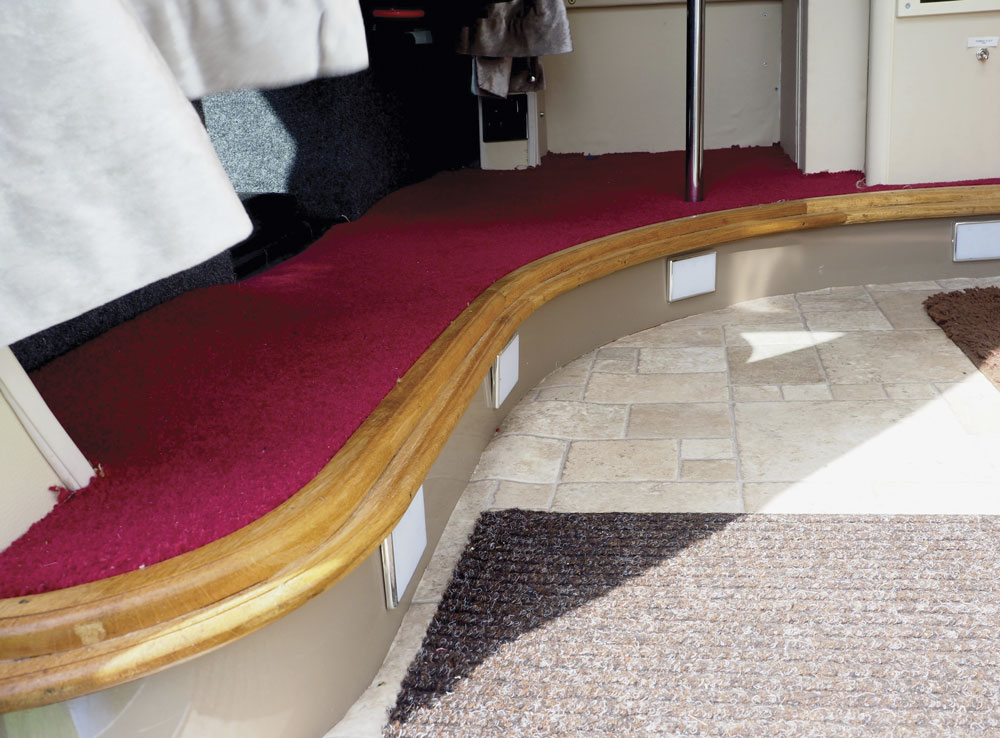
Another campervan building lesson learned
While the sink, hob, shower, skylights and toilet fittings are off-the-shelf products, the carcasses for the seating, the cupboards, washroom, beds, worktops and trim are all handmade from a mix of soft wood, hard wood, marine-grade plywood and genuine Formica. Peter even made the foam cushions himself before using a local upholsterer to make the covers.
He says he used 5in upholsterers’ foam with 1in memory foam on top. “I bonded them, cut them and got them all to size. That saved me quite a lot of money. The foam is not cheap, so I shopped around to get the best deals. In fact, I ended up buying it off eBay, I think.”
It was not the first time he’d searched for the best price and best materials: “I always did this for my customers in the building trade. I would get the very best prices,” he said. “I’ve done the same with the campervan, right from the van itself all the way through to the fittings.”
One noticeable feature of Explorer - Peter and Sandra’s name for the camper - is the Formica-covered doors and worktops. Peter laminated them all by hand using a gallon of Evo-Stik adhesive in the process. He said: “When you use Evo-Stik, a good marine ply, and you bond Formica on top, it is there for life.” But he ensured he did all the work with proper ventilation, having learned the hard way when he passed out inside a boat back in his boatbuilding days. “I had a terrific headache when I woke up. I really learned my lesson, about working in confined spaces with Evo-Stik!”
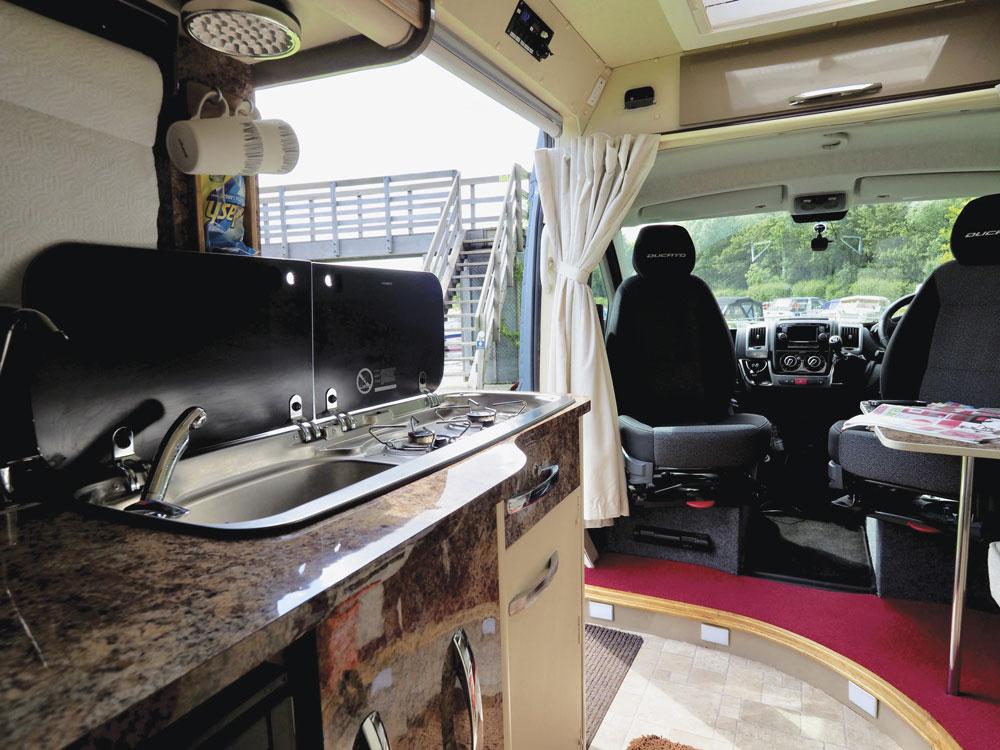
Putting the finishing touches to the campervan
Peter was used to his works vans not having rear side windows, so when it came to a campervan conversion he saw no need for them. His tricks of the trade came in useful again. Putting mirrors in the right place makes all the difference,” he revealed. “They give you a feeling of width.”
There is no denying that Explorer has all the feel of a professional conversion. Peter’s quality work and its individuality are evident all around. Nowhere more so than in the oak edging to the step in the forward end of the accommodation, which is quite special.
Inevitably, comparisons are made to boatbuilding and when remarking how boat-like the campervan was, one friend asked him why he had gone to the bother of making the solid oak step.
“Because I could, and I had the time,” he answered. “It’s made out of six pieces of straight solid oak cut on a band saw,” he explained. “The moulding is cut on a spindle. It’s what we used to do in the boats, and something I wanted to replicate to make it look that bit different. But it took me about three weeks.”
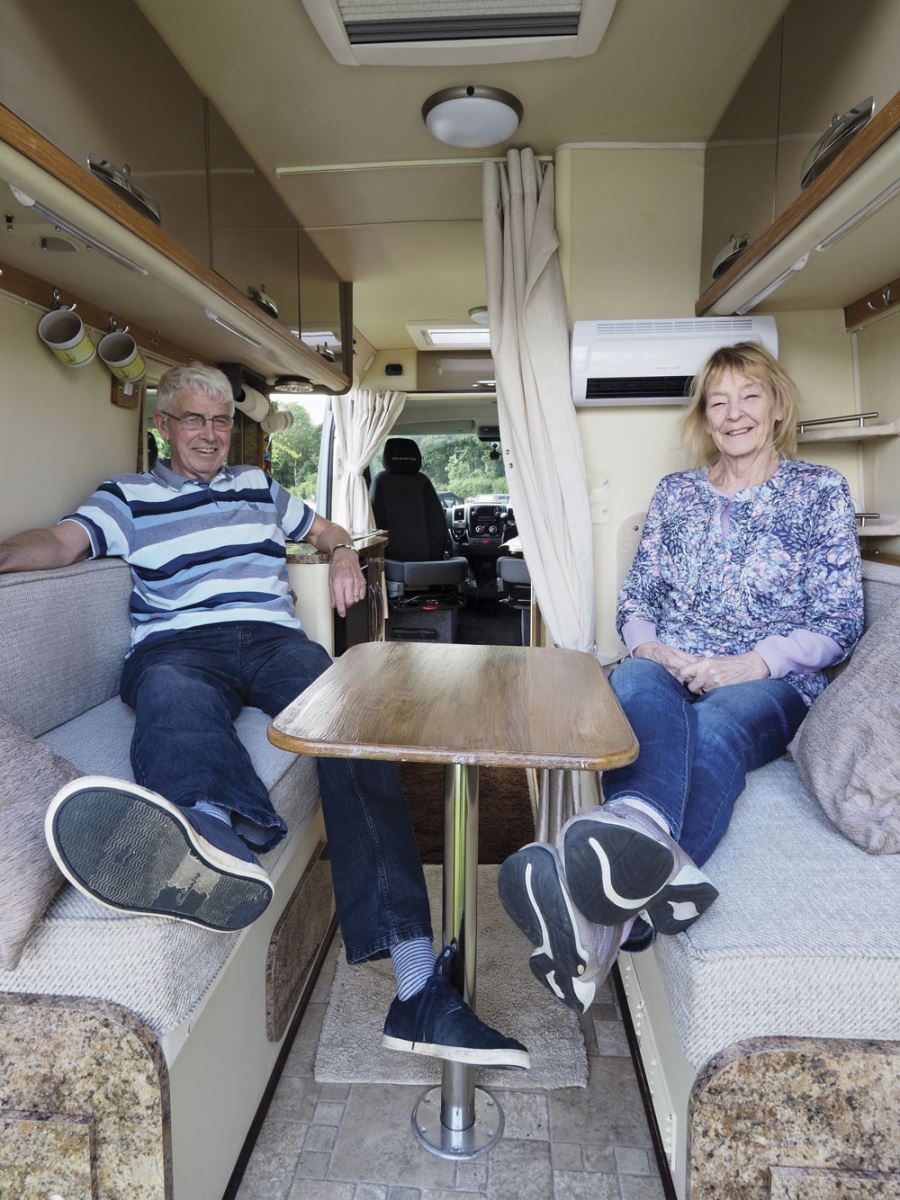
When asked if there is anything he would change about his bespoke campervan conversion, Peter remarked:
“I'm going to sound big-headed now if I say no, aren’t I? Unfortunately, due to ill health, we've only been out on a few day trips, but I've tried everything out in it and I cannot fault it!"
Peter admits that he is not a typical campervan owner and had a head start with the skills needed to do a home conversion. Although he has posted a video of the conversion process on YouTube he counsels against following all advice available online. Much, he says, is not helpful, while some is also dangerous. He looks forward to getting out in Explorer enjoying the self-contained, independent life, but he’s philosophical: “I’m 72 and I don’t know how long I’ve got left. If I go into a venture I do it seriously. I have no intention of selling in the near future. No matter what happens, I’ve got it for life.”
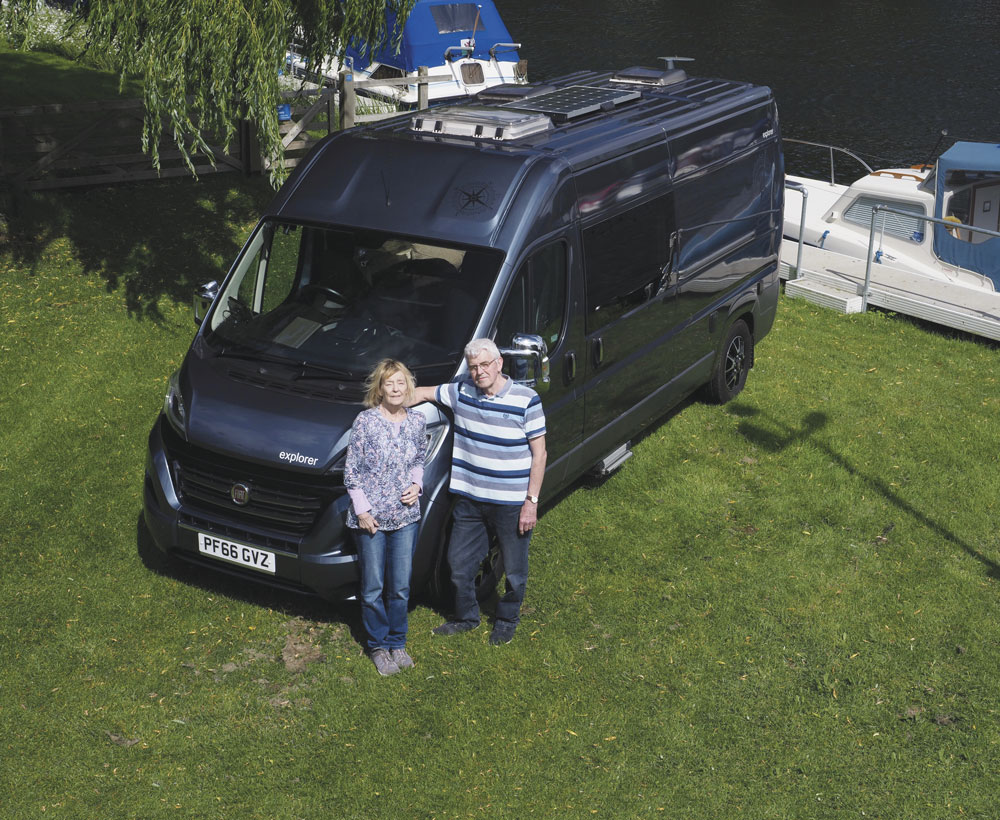
Peter’s campervan project - the Explorer
Base vehicle: 2016 Fiat Ducato LWB
Engine: 2.3-litre diesel Multijet (Euro 6)
Power: 130bhp
Travel seats: 4
Berths: 3
Length: 6m
Width: 2.05m
Height: 2.56m
Campervan project - the costs so far
The van: £15,000
Materials: £7,327
Total costs to date: £22,327











Recent Updates
Engine management lights: all you need to know
What is the engine management light? What does it mean, and what do I have to do? ...
Motorhome air suspension: all you need to know
Motorhomes are heavy and the additional weight of equipment and height of the bodywork can increase the loads ...
Motorhome WiFi: how to get better motorhome internet
Staying connected on the move is more and more essential, so relying on campsite WiFi isn't an option – here ...
A class of their own - our guide to A-class motorhomes
Thinking of trading up to an A-class, or even going straight to the top of the motorhome tree? We guide you ...
Explore overseas on a motorhome dream tour
Enjoy exotic travel in a campervan or motorhome by hiring, swapping with someone else or exporting your ...
Motorhome water systems: everything you need to know
On-board water is an important part of every motorhome – here’s everything you need to know ...
Campervanning in Europe: what you need to know
Whether you're planning a leisurely drive through the French countryside, navigating bustling city streets in ...
Campervan security: all you need to know
With thefts on the increase, it’s important to know how to keep your campervan secure and prevent campervan ...
Campervan furniture: everything you need to know
Our campervan experts guide you through all the essentials for your campervan, including tables, chairs, ...
Campervan finance: how to fund your purchase
Here we look at the different types of campervan finance available, to help you decide what’s the best option ...
Other Articles
Britain’s best used motorhomes
Want a great motorhome without paying the premium for a new one? Here's a guide to the best you can get in the pre-owned market for each layout, ...
Which motorhome? Choosing the perfect motorhome for you
Choosing a motorhome or campervan is one of the biggest buying decisions you’ll ever make, so it's important ...
Campervan washroom essentials: stay fresh on the road
Our guide will take you through the campervan washroom essentials you'll need so you're well-prepared for ...
Dogs in campervans: all you need to know
Follow our advice and your dog will enjoy campervanning as much as you do ...
Electric campervans: all you need to know
Our guide will take you through everything you need to know about electric campervans and what the future ...
Motorhome electrics: a complete guide to your motorhome electrical set-up
Motorhome electrics can dramatically enhance the convenience and comfort of your vehicle – but they can be ...
Lighting for campervans: all you need to know
We guide you through all the lighting options available for you and your campervan, including interior ...
Electric bikes for motorhomes: our ultimate guide
Read our comprehensive guide to electric bikes for motorhome owners, helping you add electric power to your ...
Our guide to 'cheap' motorhomes in 2024
If you're on the hunt for an affordable new motorhome, this is the best place to start – we've rounded up a ...
Campervans in winter: all you need to know
Here's your guide to preparing your campervan for the colder months, whether you will be using it or putting ...